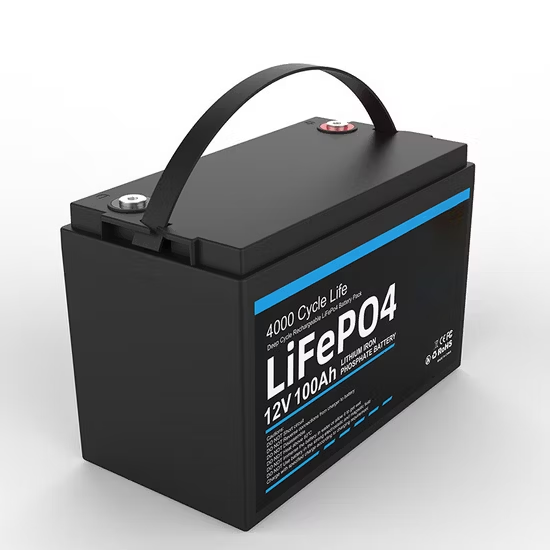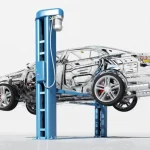Lithium iron phosphate (LiFePO4) batteries have become popular in RV power systems due to their superior energy density and lightweight design. Compared to traditional lead-acid batteries, LiFePO4 cells offer more watt-hours of capacity per pound, making them compact and easier to fit into limited RV spaces. The reduced weight of these batteries not only saves storage space but also improves fuel efficiency when driving, which is especially beneficial on long trips.
Key Benefits of LiFePO4 Batteries in RVs
- Lightweight and Compact: LiFePO4 batteries typically weigh much less than lead-acid batteries. This lighter weight helps RV owners carry more usable power without exceeding vehicle weight limits. The compact size of lithium cells also means you can often install more battery capacity in the same area.
- High Usable Capacity: These batteries allow much deeper discharge than lead-acid. Most LiFePO4 cells can safely use 80–90% of their capacity, whereas lead-acid should usually stay above 50% to avoid damage. That means a 100Ah LiFePO4 battery can deliver far more usable power (around 80–90Ah) compared to about 50Ah for a 100Ah lead-acid battery. This deeper discharge capability is great for boondocking longer without hookups.
- Long Cycle Life: LiFePO4 batteries can last for thousands of charge/discharge cycles under normal use, often in the range of 4000–15000 cycles. In contrast, typical RV lead-acid batteries last only a few hundred cycles (about 300–500 cycles) before they need replacing. In real terms, a well-maintained LiFePO4 battery may serve 8–10+ years or more, far longer than traditional batteries.
- Fast Charging: Lithium batteries can recharge much faster than lead-acid types. In many cases, a fully discharged LiFePO4 battery can be recharged in just a few hours (often 2–3 hours for a 12V 100Ah battery) when using a powerful charger. This is roughly 3–5 times faster than the same-size lead-acid battery, which may need 6–10 hours to fully charge. Faster charging means less downtime waiting to top off.
- Consistent Power Output: LiFePO4 batteries maintain a more constant voltage throughout most of their discharge cycle, providing stable power to RV appliances and electronics. In contrast, lead-acid battery voltage drops steadily as they discharge. With lithium, you can count on steady performance until the battery is nearly empty.
- Low Maintenance and Safety: LiFePO4 cells are sealed and maintenance-free. They do not require watering, and they do not emit flammable hydrogen gas like flooded batteries. Additionally, quality LiFePO4 batteries include built-in Battery Management Systems (BMS) to protect against overcharge, deep discharge, short circuits, and extreme temperatures. These features make LiFePO4 a safer, more user-friendly choice for RVers.
Choosing the Best Lithium Battery for Your RV
Finding the best lithium battery for RV involves balancing power capacity, weight, and cost. First estimate your daily energy usage in watt-hours to guide capacity needs. For example, a 100Ah 12V LiFePO4 battery stores about 1280Wh, delivering roughly 1000Wh of usable energy at 80% discharge. To increase capacity, RVers often connect multiple batteries in parallel or series. When choosing a battery, also check its continuous discharge rating (C-rate) and cycle life. A quality LiFePO4 battery should support thousands of cycles and include built-in BMS safety features.
Understanding LiFePO4 Battery Chargers
A dedicated lifepo4 battery charger is essential for charging lithium RV batteries correctly. Unlike lead-acid chargers, LiFePO4 chargers use a tailored charge algorithm that matches the voltage and charging characteristics of lithium cells. LiFePO4 charging typically follows a two-stage process: a constant-current phase up to about 14.4–14.6V (for a 12V battery) and then a constant-voltage phase until the current tapers off. There is no need for a float stage as with lead-acid batteries, and the charger will stop automatically once the battery is full. These specialized chargers ensure the battery is charged efficiently and safely.
Selecting the Right LiFePO4 Charger for Your RV Battery
When shopping for a LiFePO4 charger, keep the following guidelines in mind:
- Voltage Match: The charger’s output voltage must exactly match the battery’s nominal voltage (e.g. ~12.8V for a 12V LiFePO4 pack). A mismatched voltage can undercharge or overcharge the battery.
- Appropriate Current: A common rule of thumb is to charge at 0.5C to 1C of the battery’s capacity. For a 100Ah battery, that means a charger capable of about 50A to 100A output. Charging at 0.5C is gentler and extends battery life, while 1C (or higher) will charge faster if needed.
- Charging Algorithm (CC/CV): Choose a smart charger that uses a constant-current / constant-voltage profile tuned for LiFePO4. This ensures efficient charging and proper cut-off when the battery reaches full voltage.
- Built-In Protections: Look for chargers with safety features such as over-voltage protection, thermal cutoff, and short-circuit prevention. These safeguards protect both your battery and your RV’s electronics.
- Multi-Bank Capability: If you run multiple battery banks (for example a dual 12V setup), consider a multi-bank charger that can charge each battery independently. This helps ensure each battery receives the correct charge.
Maintenance and Best Practices
LiFePO4 batteries require less upkeep than flooded batteries, but following some basic guidelines will extend their life. Always use the proper LiFePO4 charger and avoid routinely keeping the battery at 100% or 0% State of Charge. Instead, many owners cycle between about 20% and 90% SOC. In cold weather, avoid charging LiFePO4 below 0°C unless the battery has built-in heaters or the charger is designed for low temperatures; charging in freezing conditions can damage the cells. If your RV has solar panels, set the solar charge controller to a lithium battery charging profile (around 14.4–14.6V absorption, no float stage) to ensure proper charging throughout the day.
Conclusion
Switching your RV to lithium LiFePO4 batteries can transform your travel experience with lighter weight, increased usable capacity, faster charging, and longer battery life. Although LiFePO4 batteries may cost more upfront, they often prove more economical over time due to their multi-thousand-cycle lifespan. To fully benefit from these advantages, always pair your LiFePO4 battery bank with a high-quality, dedicated lifepo4 battery charger that matches the battery’s specifications. By carefully selecting the right battery and charger, RV owners can enjoy reliable, maintenance-free power for years to come. Ultimately, switching to LiFePO4 means more power, less maintenance, and peace of mind on the road.







